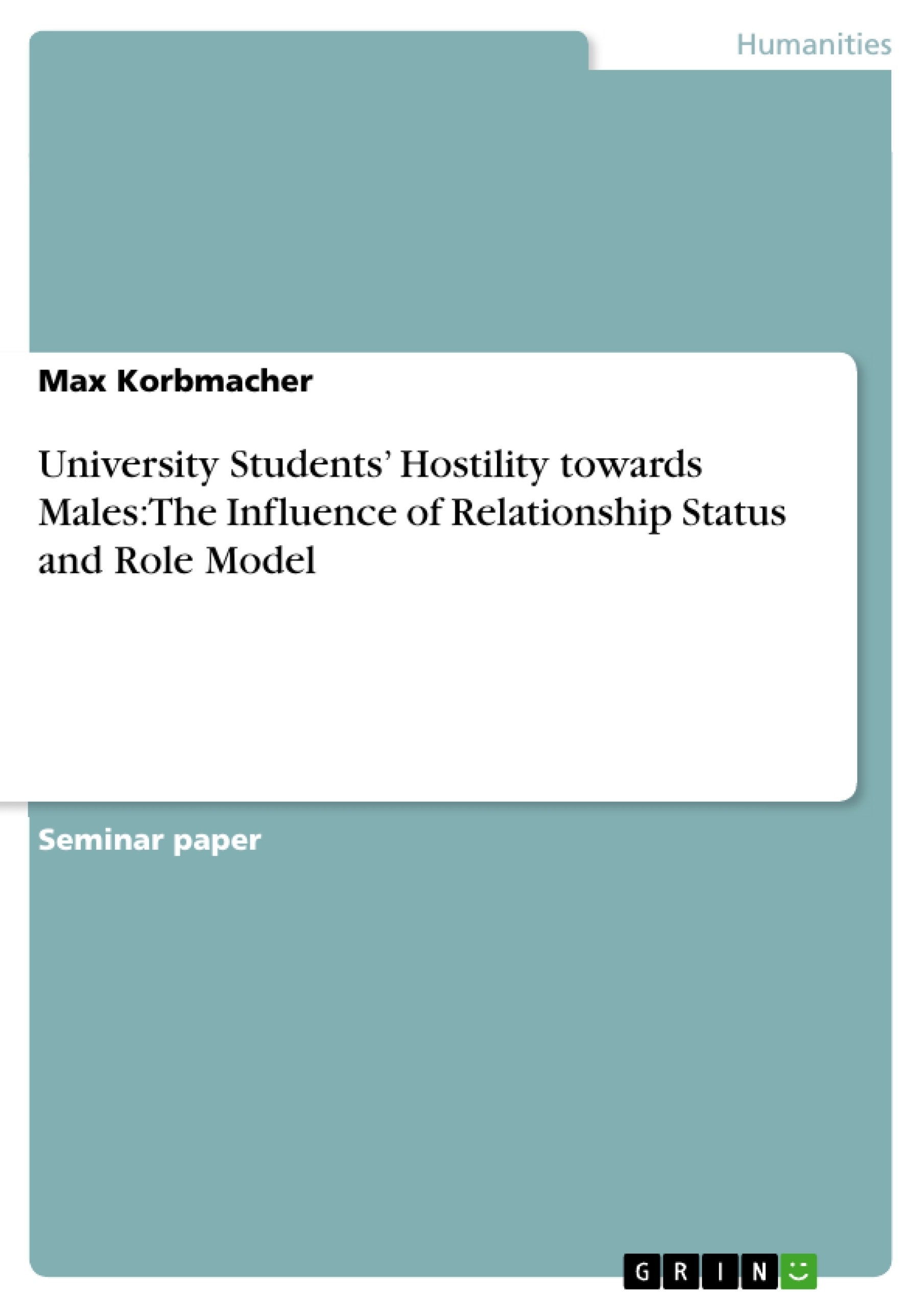Excerpt
Abstract
The aim of this study was to examine whether the two variables (1) relationship status and (2) role model have an influence on hostility towards males. 81 undergraduate psychology students of the Abertay University Dundee (UK) filled out two questionnaires. The Ambivalent Sexism Inventory was used in the first questionnaire and the Ambivalence Towards Men Inventory in the second questionnaire to measure sexist attitudes. It was predicted that that participants’ (1) relationship statuses and (2) role models would influence their mean score on hostility towards males (HM). Results demonstrated that there was no influence of (1) relationship status or (2) role model on hostility towards males. It was concluded that sexism and ambivalent attitudes are influenced by a variety of factors which need further consideration in future research.
Method
Participants
A convenience sample of N = 81 second year psychology students of the Abertay University Dundee (Scotland) was used. All students in the Social Psychology course in the Spring Semester 2017 were asked to participate in the study in lectures and via email. However, the participation was voluntary. The participants were aged 23.8 years on average. The participating N = 20 males had a mean age of 22.65, and the N = 61 females a mean age of 24.15. 48 of the participants were in a relationship, 33 were single. Descriptive revealed that 6 participants were in a male role model, 22 in a female model, 42 in the mixed (male and female) role model and 11 without role model.
Materials
Google Forms was used to prepare 2 online questionnaires with a randomised order of questions. Therefore, two inventories were used; one questionnaire used the Ambivalent Sexism Inventory (ASI; Glick & Fiske, 1996) and the other the Ambivalence Towards Men Inventory (AMI) to measure hostile and benevolent sexist attitudes (Glick & Fiske, 1999). The ASI measures hostile and benevolent sexist attitudes of males towards females by measuring “Paternalism (dominative and protective), Gender Differentiation (competitive and complementary), and Heterosexuality (hostile and intimate)” (Glick & Fiske, 1996, p. 495).
Statements like “Women exaggerate problems they have at work” were used to measure hostile attitudes towards females. Benevolence towards females was measured with statements like “A good woman should be set on a pedestal by her man” for measuring paternalism, “Women, compared to men, tend to have a superior moral sensibility” for measuring gender differentiation and “Every man ought to have a woman whom he adores” for measuring heterosexuality respectively. The AMI measures hostile and benevolent sexist attitudes of female towards males, each with three sub factors that address issues of male structural power (paternalism and its counterpart, maternalism), gender differentiation, and sexuality (Glick & Fiske, 1999). An example for statements which measured paternalism is “Men will always fight for greater control in society than women”, for gender differentiation “When it comes down to it, most men are really like children”, and for sexuality “Most men sexually harass women, even if only in subtle ways, once they are in a position of power over them” respectively. Examples for items measuring benevolence towards men were for maternalism: “Men are mainly useful to provide financial security for women”, for gender differentiation: “Men are more willing to put themselves in danger to protect others” and for heterosexuality: “Every woman needs a male partner who will cherish her” respectively.
The questions measured mentioned elements of hostile and benevolent sexism by using a 6 point Likert scale from 0 to 5 (0- strongly disagree to 5- strongly agree). The questionnaire contained 4 demographic questions about age, gender, relationship staus and role mode (by self-classification) and another 42 questions measuring equally benevolence and hostility towards females and males. 22 of those 42 questions measured benevolence and hostility towards women and 20 towards men respectively.
Procedure
Participants were asked to complete a questionnaire pooling two questionnaires one measuring their attitudes (benevolence and hostility) towards females, the other towards males. The questionnaires were available online and had to be completed independently. After the official deadline to complete the questionnaire, participants were debriefed in class.
Results
Abbildung in dieser Leseprobe nicht enthalten
The graph shows participant’s hostility scores by participant’s relationship statuses ‘in a relationship’ and ‘not in a relationship’. Participants in a relationship scored higher on hostility towards males (Mean = 2.34, CI’s 2.1 and 2.6) than participants who were not in a relationship (Mean = 2, CI’s 1.69 and 2.32).
A Man Whitney U test could not reveal that group differences were significant (p = .209).
Abbildung in dieser Leseprobe nicht enthalten
The graph shows participants’ hostility scores by their role model. The 4 role models male, female, male and female, and no role were used. Participants with the male role model scored the highest on hostility towards males (Mean = 2.34, CI’s 2.01 and 2.67), followed by no role model (Mean = 2.3, CI’s 1.45 and 3.15), and the female role model (Mean = 2.22, CI’s 1.79 and 2.65). The lowest score on hostility towards males had the participants of the male and female role model (mean = 2.15, CI’s 1.88 and 2.41).
A one-way between subjects ANOVA revealed that group differences were not significant (F(3,77) = .139, p = .937).
[...]
- Quote paper
- Max Korbmacher (Author), 2017, University Students’ Hostility towards Males: The Influence of Relationship Status and Role Model, Munich, GRIN Verlag, https://www.grin.com/document/370660
Publish now - it's free






















Comments